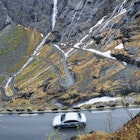With glacier-hewn fjords and deep green forests to gaze upon, traveling around Norway is an arresting experience however you choose to do it.
Served by a combination of state-wide, private and municipal companies, Norway’s transportation network is extensive and efficient. And although journeys can be long, services across the board are usually very comfortable.
You can buy tickets for almost every trip online or via an app, often at a discount. A good place to start is the national public transport planner EnTur (also available as an app). It pulls together routes on all modes of transport in the country, though you’ll mostly have to purchase tickets directly from each service operator.
Ferries and boats are the most scenic way to travel
Ferries crossing the fjords take cars, foot passengers and cyclists – simply pay the attendant on board. There are more services in summer, but even then, there can be long lines to board.
Norway’s famous Hurtigruten coastal ferry calls at 34 ports from Bergen to Kirkenes. The focus is on premium cruise packages, but it is possible to book individual legs – look for the "port to port" option on the website. Several ports, such as Geiranger, aren’t served at all during the low season.
Some express boat crossings (Bodø to Svolvær, for example) can be very rough. If you suffer from seasickness, you may prefer to fly. If not, pack those seasickness tablets.

Norway's train network includes sleeper routes
Run by government-owned railway company Vy (formerly NSB), the country’s rail network links major cities such as Oslo, Bergen, Trondheim and Bodø. The system is reliable, and trains in Norway have spacious carriages with plenty of room for luggage.
Sleeper trains run on some longer routes and offer a genuinely brilliant alternative to flying. Compartments are small but clean and comfortable – the only thing likely to keep you awake is the view.
The downside is that fares can be expensive. Tickets go on sale 90 days in advance, and booking even a few days before traveling can get you a much cheaper fare. Check train timetables and book tickets on the Vy app or website, or buy from the multilingual ticket machines in stations. You can also pay onboard using a credit or debit card.
Tip for traveling on the train network: You may hear discounted advance fares described as minipris tickets. This is the old NSB term, and you won’t see it as an option when you purchase through Vy.
Buses are the only option for visiting rural areas
Buses in Norway are cheaper than trains, and you’ll be reliant on them in more rural areas. The bus network is efficient, but there are far fewer services on weekends and outside of the high season (June to August).
Long-distance routes are covered by state-owned Vy and private outfits, including Nor-Way Bussekspress and Lavprisekspressen. Buying tickets in advance will guarantee you a seat, but you can usually turn up and pay on board.
Tip for traveling on bus routes with ferry crossings: Local buses are managed by each municipality, and some routes involve ferry crossings. On long-distance routes, the coach just rolls on and off again, but sometimes you need to get on the ferry as a foot passenger and pick up a different bus when you get off. Services generally link up, so buses wait for passengers to alight the ferry before departing.

Hiring a car in Norway will stretch your budget
Driving undoubtedly offers the most flexibility if you’re planning to visit very remote places. You’re unlikely to need an international driving license for short stays (check with the Norwegian Public Roads Administration), but there are some things to bear in mind before you rush to hire a car.
Journeys often involve negotiating fjords and ferries, so traveling even short distances will take much longer than you expect. Driving in winter can be daunting if you’re not used to ice and snow, and smaller roads can close altogether.
Car hire is also expensive (though the rate drops for longer rental periods), and companies often charge more if you’re under 25. The price of fuel is high – even by Norwegian standards – and you’ll also need to factor in the cost of ferries and tolls. It can all add up to be a very pricey road trip.

Domestic flights are best if you're short on time
If you’re really short on time and have your heart set on visiting very disconnected cities, domestic flights are usually the most feasible way to travel. It can often be cheaper than taking the train, though the cost to the environment is something to consider.
Norwegian and SAS serve the country’s main cities, while Widerøe hops to the smaller airports.
Public transportation in cities is easy to use
Local transport in Norway is handled by the local municipality, and each one has its own website or app for timetables and tickets. Some systems are flashier than others, but most are straightforward to use. Oslo’s is Ruter, Bergen’s is Skyss, and Trondheim uses AtB.
Oslo has an extensive transport network
Oslo’s easy-to-navigate public transportation system is coordinated by Ruter. It covers all metro (T-bane), bus, tram and ferry services in the city. Most attractions are in zones 1 and 2 (two-zone ticket: single/24hr/7 days 69/209/615kr). Download the Ruter app to plan your journey and buy tickets, or buy them from the self-service kiosks at stations and stops. Tickets are valid for any mode of transport on the Ruter network.
The T-bane has five color-coded lines, all of which stop at Nationaltheatret and Jernbanetorget (for the city's main train station, Oslo S). Trams zip along six lines, and all pass through Oslo S, while buses serve lots more of the city, including the museums at Bygdøy.
Tip for travel in Oslo: Buying an Oslo Pass (24/48/72hr 520/760/895kr) gives you free entry to most museums and includes free transport in zones 1 and 2.
Accessible transportation in Norway
Provision for travelers with disabilities in Norway is good, though not perfect. If you’re taking an intercity bus, train or boat, you may have to call ahead at least 24 hours in advance to book assistance for your journey.
Local buses are almost always wheelchair-accessible and newer long-distance coaches have wheelchair lifts. T-bane stations in Oslo have lifts or ramps to access the platform, though there’s often a gap between the platform and the train. All trams in Bergen are wheelchair accessible, but trams on some lines in Oslo (lines 11, 12 and 19) are not.
Metro, tram, and bus stops in larger cities have digital displays of upcoming services. The next stop is announced when on board and assistance dogs are generally welcome.
Find out more on our accessible travel resource page.











